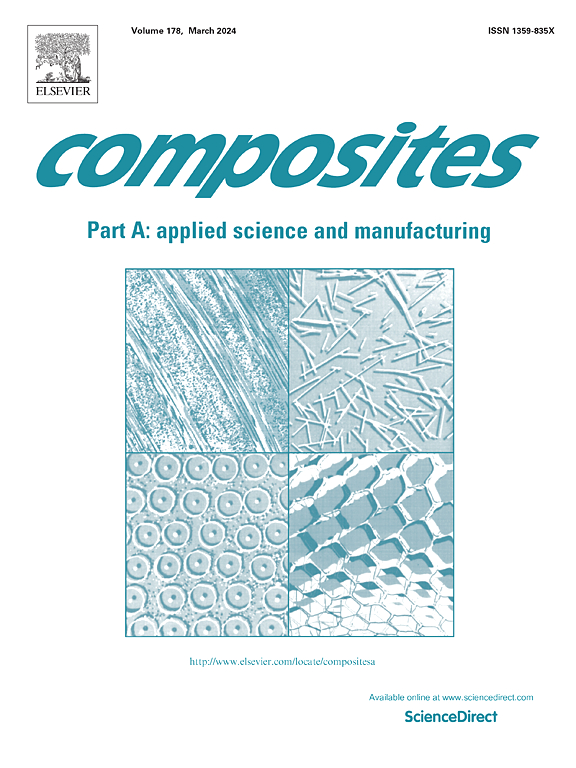Tailoring interlaminar shear and mode-I fracture behavior in fiber-composites via soft self-healing thermoplastic inclusions
IF 8.1
2区 材料科学
Q1 ENGINEERING, MANUFACTURING
Composites Part A: Applied Science and Manufacturing
Pub Date : 2025-02-27
DOI:10.1016/j.compositesa.2025.108803
引用次数: 0
Abstract
The hierarchical microstructure of fiber-reinforced composites (FRC) enables lightweight materials with exceptional mechanical properties. However, their layered architecture is prone to interfacial damage, notably delamination. An effective strategy to mitigate delamination is by integrating thermoplastic interlayers, which not only enhance FRC resistance to interfacial fracture, but also enable self-repair of cracks through thermal mending. In this study, we demonstrate for the first time, repeated in situ self-healing of FRC laminates under both mode-I fracture (via the double cantilever beam) and 3-point flexure (employing short-beam shear). Remarkably, we achieve nearly complete restoration over ten consecutive healing cycles from thermal remending of 3D-printed poly(ethylene-co-methacrylic acid) (EMAA) interlayer inclusions. To understand the mechanical effects of such soft inclusions, we conduct a comprehensive experimental and numerical investigation. Our research findings reveal: (i) Markedly different strain states in short-beam shear with soft inclusions compared to FRC without. (ii) The necessity of incorporating contact algorithms for accurate finite element (FE) simulation of local stress/strain fields and global structural responses. (iii) Adjustments in the density and layer placement of printed EMAA domains can tailor both interlaminar shear strength (ILSS) and mode-I fracture resistance (). This research offers newfound insights into realizing self-healing in actual structures, reliable and efficient simulation strategies for modelers, and advancements towards more modern design motifs and suitable materials testing protocols.

通过柔软自愈热塑性夹杂物剪裁纤维复合材料的层间剪切和i型断裂行为
纤维增强复合材料(FRC)的分层微观结构使轻质材料具有优异的机械性能。然而,它们的分层结构容易造成界面损伤,特别是分层。一种有效的缓解脱层的策略是集成热塑性夹层,这不仅可以增强FRC对界面断裂的抵抗力,还可以通过热修补实现裂缝的自我修复。在这项研究中,我们首次证明了FRC层压板在i型断裂(通过双悬臂梁)和三点弯曲(采用短梁剪切)下的重复原位自愈。值得注意的是,我们通过热修复3d打印聚(乙烯-甲基丙烯酸)(EMAA)层间包体,在连续十个愈合周期内实现了几乎完全的修复。为了了解这种软夹杂物的力学效应,我们进行了全面的实验和数值研究。研究结果表明:(1)含软夹杂物的短梁剪切应变状态与不含软夹杂物的短梁剪切应变状态明显不同。(ii)结合接触算法对局部应力/应变场和整体结构响应进行精确有限元模拟的必要性。(iii)调整打印EMAA结构域的密度和层位可以定制层间剪切强度(ILSS)和i型抗断裂能力(GIC)。这项研究为实现实际结构的自我修复提供了新的见解,为建模者提供了可靠和有效的模拟策略,并朝着更现代的设计主题和合适的材料测试协议取得了进展。
本文章由计算机程序翻译,如有差异,请以英文原文为准。
求助全文
约1分钟内获得全文
求助全文
来源期刊

Composites Part A: Applied Science and Manufacturing
工程技术-材料科学:复合
CiteScore
15.20
自引率
5.70%
发文量
492
审稿时长
30 days
期刊介绍:
Composites Part A: Applied Science and Manufacturing is a comprehensive journal that publishes original research papers, review articles, case studies, short communications, and letters covering various aspects of composite materials science and technology. This includes fibrous and particulate reinforcements in polymeric, metallic, and ceramic matrices, as well as 'natural' composites like wood and biological materials. The journal addresses topics such as properties, design, and manufacture of reinforcing fibers and particles, novel architectures and concepts, multifunctional composites, advancements in fabrication and processing, manufacturing science, process modeling, experimental mechanics, microstructural characterization, interfaces, prediction and measurement of mechanical, physical, and chemical behavior, and performance in service. Additionally, articles on economic and commercial aspects, design, and case studies are welcomed. All submissions undergo rigorous peer review to ensure they contribute significantly and innovatively, maintaining high standards for content and presentation. The editorial team aims to expedite the review process for prompt publication.
 求助内容:
求助内容: 应助结果提醒方式:
应助结果提醒方式:


